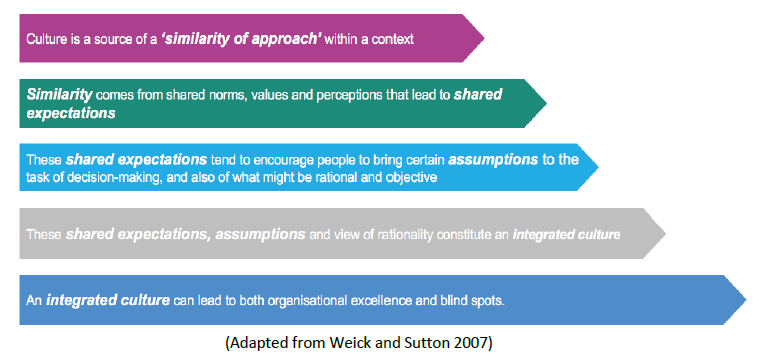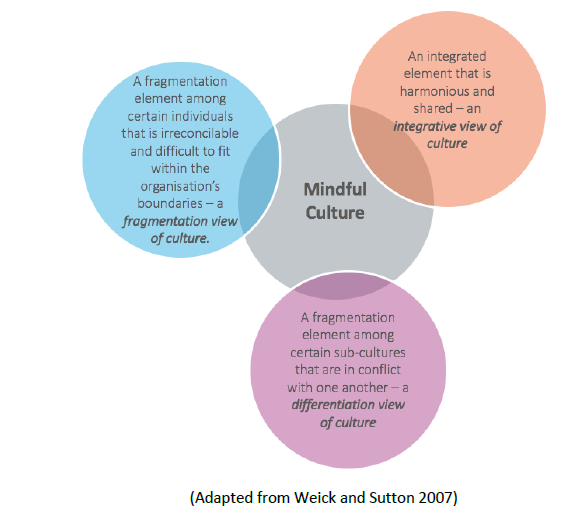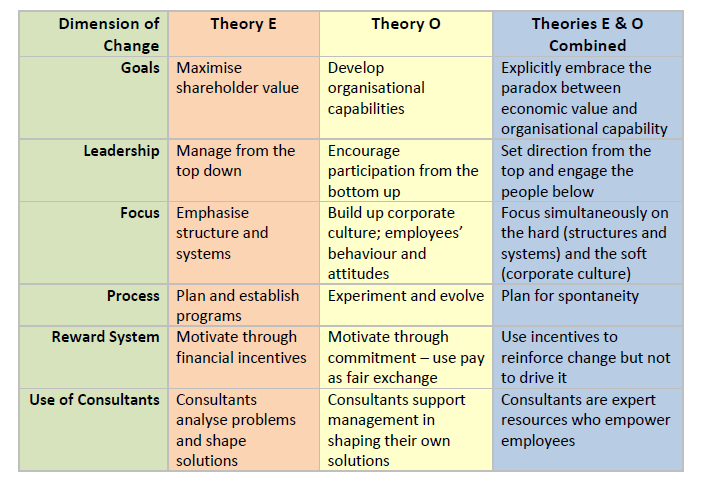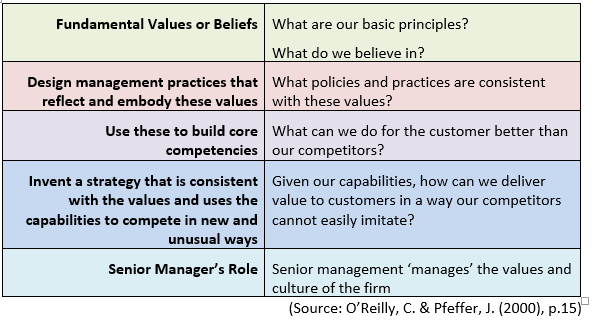Module 5: Enacting Change – Enabling for powerful performance
Topic 5.4: Culture and Lived Values in the Change Process
Culture is a set of assumptions that help keep lessons learned from dealing with the internal and external environment. Values are derived from those assumptions that prescribe how the organisation should act. These become the foundation of the practices and way of doing business with an organisation’s clients and stakeholders. Finally, various artefacts or visible markers – symbols- help to make tangible to those espoused values.
Required
Weick, K. E., & Sutcliffe, K. M. (2011). Chapter 6: Organizational Culture : Institutionalizing Mindfulness. In Managing the Unexpected: Resilient Performance in an Age of Uncertainty (2nd ed., pp. 109–138). Wiley.
Please read only chapter 6.
Corporate culture is what holds groups and organisations together (Weick & Sutton, 2007)[1]. Culture emerges from the set of expectations that we have of people in a specific context, and from the expectations that matter to those involved. An important point is that people shape culture, and culture shapes people.
Weick & Sutton (2007) note the following:
Figure 5.2 Culture
Furthermore, a mindful culture will have three elements:
Figure 5.3 Mindful Culture
This matters because of the way that organisations, and its members, handle ambiguity. Integrative cultures tend to deny ambiguity; differentiated cultures tend to tacitly accept ambiguity, with caveats. Fragmented cultures openly accept ambiguity. Thus, differentiated and fragmented cultures allow for more variety (remember the requisite variety discussion).
So, depending on the nature and complexity of the tasks at hand, leaders should be mindful of the need to match the level of complexity of the environment with the level of complexity of the system. Wise practices either reduce environmental complexity or increase system complexity (Weick & Sutton, 2007). While you may not be able to directly influence organisational practices, you can work with your teams to understand and operate effectively within those practices, and develop a ‘mindset’ that can ‘deliver’ within the system.
These statements relate to organisational change. Organisational change is complex, rarely works when it is ‘imposed’ – unless a crisis is the precipitating factor! It requires a very clear understanding of the organisation’s environment, so that decision makers have a realistic understanding of the potential consequences of their action. Change also typically impacts on ‘the way we do things’ – behaviours, values and culture.
So, change by its nature will be potentially threatening, and will question time-honoured systems and traditions.
Bolman & Deal (2008)[2] note the following:
Figure 5.4 Change
There are myriad approaches, theories and possibilities within the change and change management approaches. The take-out here is that there will be challenges, tension and ambiguity.
It is also possible, and almost always necessary.
It is useful in the ebb and flow of public sector management to revisit some classic ‘change’ mindsets. Let’s look at economic and organisational approaches to change (Beer and Nohria, 2000)[3].
A Theory E approach is change based on Economic value. This is the ‘hard’ approach to change, that typically involves economic incentives, potentially involving redundancies, downsizing and restructuring. The overall goal of course is to maximise ‘value’ through a focus on efficiency.
A Theory O approach is change based on organisational capability. In this so-called ‘soft’ approach to change, the goal is to develop an organisational culture and people capability through individual and organisational learning. This process of change entails iterative feedback, reflection and continual dialogue, with the view that the organisation and its people have commitment-based relationships that are crucial to the organisation’s success.
Beer & Nohria (2000) make two focused claims:
- that a strategic combination of E and O approaches, that includes a careful resolution to the inherent tensions between them, can deliver outstanding change outcomes
- that change and transformations using E, O and combined EO, can be compared along 6 dimensions (Table 5.1), that help guide the approaches to change.
Table 5.1: Comparing Theories of Change (Adapted from Beer, M. & Nohria, N., 2000).
Required
15 mins
Consider recent change initiatives that you have experienced or observed.
- Where do they ‘fit’ in the Theory E, Theory O, Combined EO framework?
- How effective do you think the change initiative has been, over the longer term?
- What changes could have been made to support an effective change process?
In conclusion, Weick & Sutton (2007:14) propose a concept of ‘acting into change’ as a change model. Their belief is that culture, values and change are closely associated. They propose these as a foundation for how culture develops:
- Basic shared assumptions that are:
- Invented, discovered, or developed by a given group:
- As it learns to cope with its problem of external adaptation and internal integration in ways that:
- Have worked well enough to be considered valid
- Can be taught to new members:
- As the correct way to perceive, think and feel in relation to those problems.
- Invented, discovered, or developed by a given group:
Conclusion
This module has helped you to develop your abilities to monitor and enhance the ways in which your organisation can deliver excellence, in particular in relation to change and innovation.
Change is a ‘messy business’! Take a look back over your observations within this module. What do you notice? What is your overall reaction to the topics? Seek to link the various concepts we have discussed.
In this module, we have argued that culture and change are strongly interrelated, and that organisational symbols and behaviours can be used to enact desirable and necessary changes within organisations.
Please sift carefully through the various pieces and find for yourself the means by which you can navigate through ‘organisational stuff’ to manage people, culture and processes to deliver on desired outcomes. Think back to the conceptual slack discussion. Consider if you should, and indeed could, embed this practice into your daily professional activities, and how could you use this as a tool within your workplace, to achieve outcomes.
To help you achieve this, in the next and final module we guide you in your examination of performance and execution management systems, that have as their primary focus, helping the organisation to remain focused on its overall objective, that of delivering public value. Inherent in such systems of course is the notion of reward and feedback. We briefly explore the nature of such systems.
Recommended
20 mins
Change through symbols entails working backwards – change the symbols and then over time the values around those symbols. Change through acting in ways that support those symbols encourages people to act their way into change. This means embedding behaviours – acting and doing – that signal particular values, with the idea that over time, behaviours will become part of the practices which shape attitudes and beliefs. Here is the ‘thinking’ underpinning this organisation-level psychological mechanism:
- Organisations act their way into what they become over time, as do people. Behaviours are public, irrevocable and mostly voluntary. This implies that organisations and the people in them are responsible for their actions.
- People over time create plausible reasons for why they chose to perform those behaviours.
- Thus reasons are discovered after the fact. These could be based on exposure to newly discovered beliefs and assumptions that are consistent with the new culture.
Simply put, organisations can aspire to be something new, sought-after and in line with their strategy and aligned with desirable symbols; or they can act as something new, and over time become that which the acts signify. A leading change expert, Jeffery Pfeffer (2007)[4] is adamant that change should be quick, bold and well-signalled!
These same principles can be applied by managers within their teams and immediate environments. You may not have influence over the larger organisation – you do have influence on what happens around you on a daily basis, as do your people. Use this wisely!
Reflection
Reflect back on important tangible and intangible symbols that exist in your workplace. These might be specific logos, layout, embedded behaviours etc., that are explicit and experienced by most organisational members.
Now consider any explicit changes that have been introduced, that have a distinct impact on your behaviour, or the expected behaviours, in relation to delivering on outcomes.
- How successful have these been?
- How have they impacted you?
Think of the recent modifications to Medicare offices and related service offices over the past several years. Regardless of your view of these changes, they do signal change, and the business-like high tech touch is evident, and has embedded new behaviours.
Consider the changes over time to the customer spaces in many banks. Lounge chairs, open spaces, customer agents and the lack of counters, signal ‘relationship’ and ‘business partner’.
Deeper Learning
30 mins
A Values based approach
Applying a values-based approach to assessing strategy effectiveness examines how the strategy ‘fits’ with the overall purpose of the organisation, and the proposed outcomes of the strategy.
Note the set of questions below in Table 2.5.
Table 2.5: A values-based view of strategy[5]
Scenario Planning and Analysis
Scenario planning is a free flowing, brainstorming way of thinking about the organisation, which works in the more turbulent and unpredictable environment in which all organisations now operate. Planning five years out is often not feasible hence the need for flexibility and tools such as scenario planning.
Scenario planning involves constructing multiple frames of future states of the external world, only some of which may be aligned with current strategy. Because it advocates contingency planning for unfavourable as well as favourable futures, it ties in well with risk management approaches which require us to at least think about what is the worst thing that could happen even if we hope it doesn’t. Scenario planning could also be used to deliver a wicked-problem-solving strategy.
The general steps of scenario planning are:
- structuring the scenario process
- exploring the scenario context
- building the scenarios
- identifying the driving forces in the environment
- undertaking a stakeholder analysis
- understanding the impact on organisational thinking and action.
Scenario planning may be uncomfortable because it is based on the premise that the way managers normally work may be wrong (Van der Heijden et al. 2002, p.63)[6].
Activity
Consider a current highly relevant initiative in which you are involved.
Revisit the various analyses you have conducted – SWOT, PESTEL etc. Choose the trends and factors that you think are ‘most likely to’ change and impact your operations.
Develop some scenarios. Perhaps includes events such as a change of government, Minister, or Director General. Then also perhaps other changes such as budget cuts, significant departure of internal expertise, etc.
How ‘robust’ and relevant is the strategy?
How might it change?
- Weick, K.E. & Sutton. K.M. (2007). Managing the Unexpected: Resilient Performance in an Age of Uncertainty, Jossey-Bass. Chapter 6: Organisational Culture: Institutionalizing Mindfulness, p.109-138. ↵
- Bolman, L.G. & Deal, T.E. (2008). Reframing Organizations: Artistry, Choice, and Leadership (4th ed.). San Francisco, US: Jossey-Bass. ↵
- Beer, M. & Nohira, N. (2000). Cracking the Code of Change. Harvard Business Review. ↵
- Pfeffer, J. (2007) What Were They Thinking: Unconventional Wisdom About Management. Harvard Business School Press. ↵
- O’Reily, C & Pfeffer, J (2000) Hidden Value: How great companies achieve extraordinary results with ordinary people, Harvard Business School Press, August 1, 2000 ↵
- Van der Heijden, K., Bradfield, R., George Burt, G., George Cairns, G. & Wright, G. (2002). The Sixth Sense: Accelerating Organizational Learning with Scenarios. Wiley and Sons. ↵






